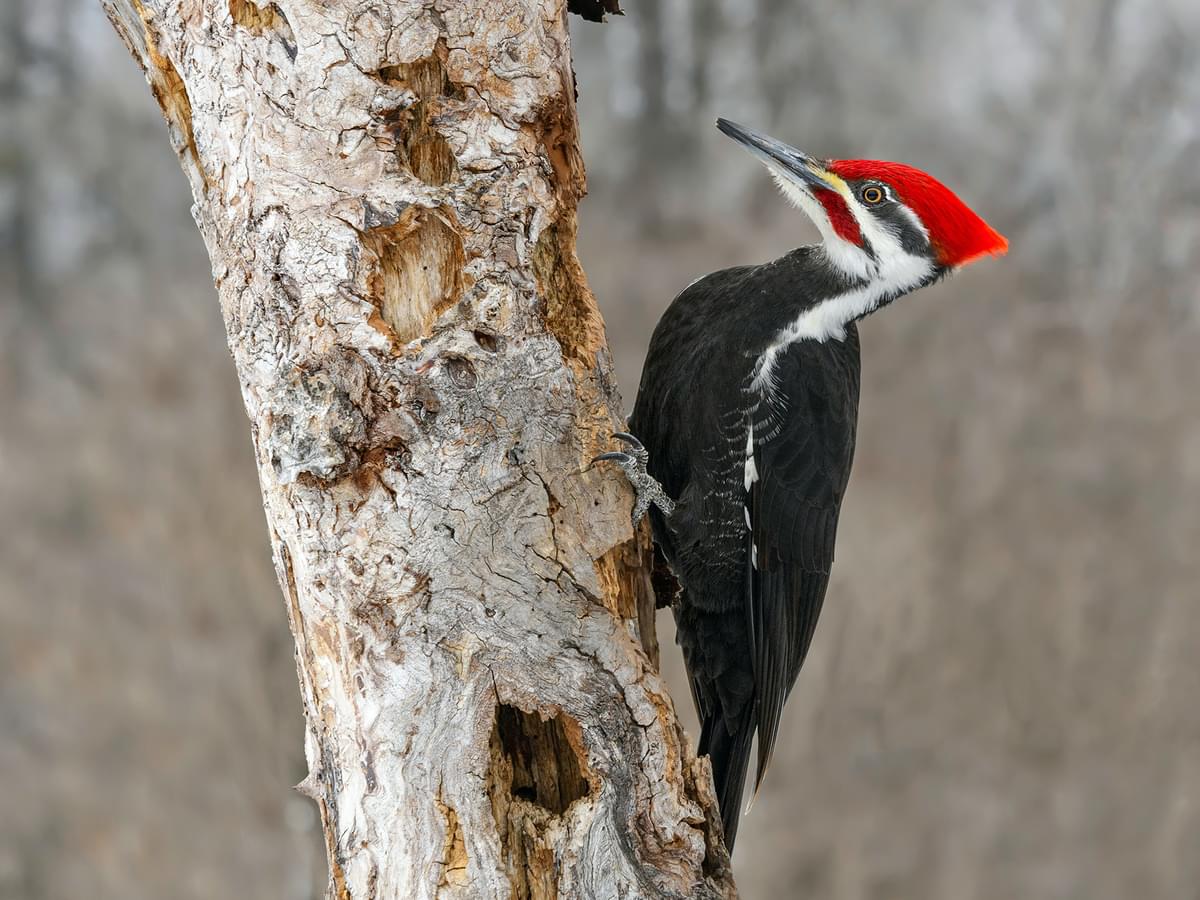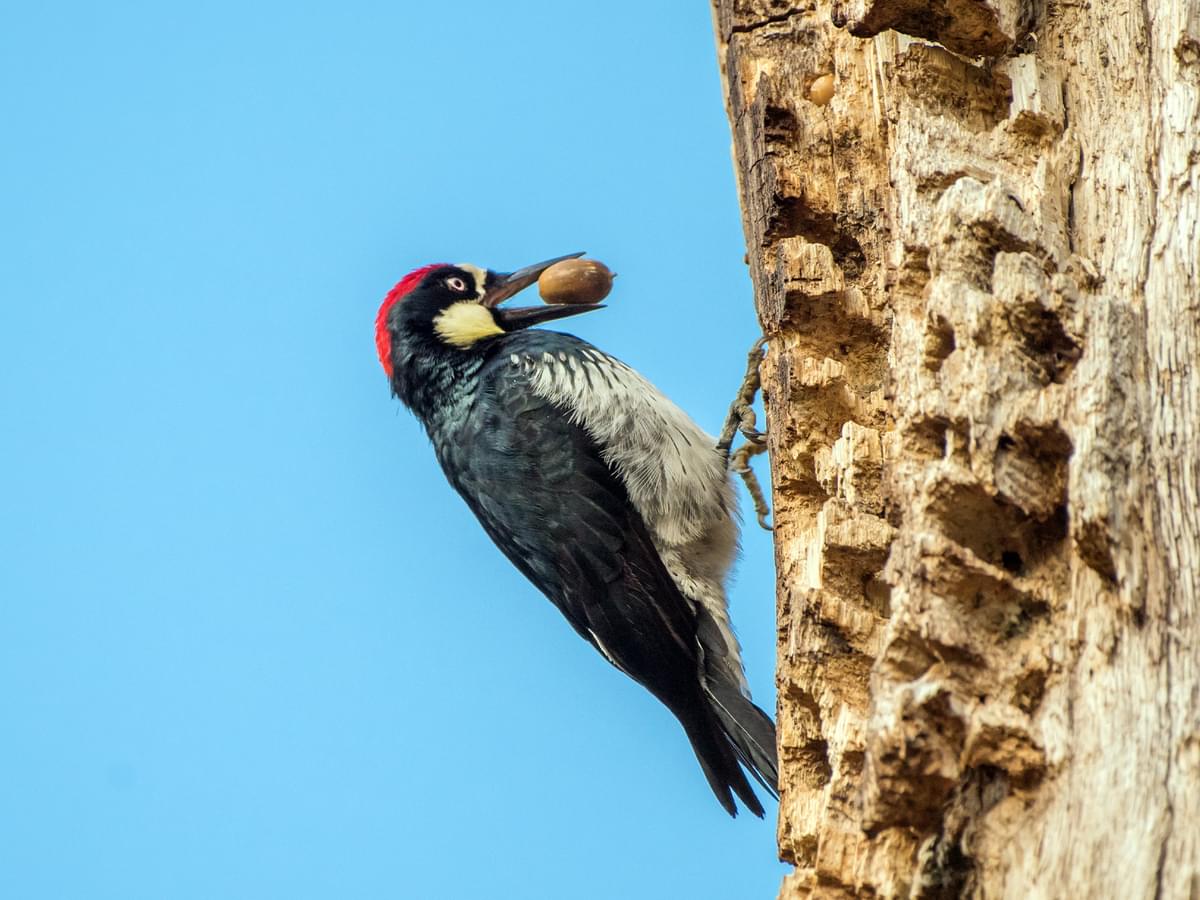Jump to Section
What Do Woodpeckers Eat? (Full Diet, Feeding, Habits + Behavior)
Last updated: 18 September 2023

Woodpeckers are a common sight and sound in woodlands, forests, and even backyards across the world. These unique birds are well-known for their amazing ability to peck holes in solid wood, but have you ever wondered why they do this and what they might be looking for?
Woodpeckers tap on wood to excavate nests and roost sites, and they drum to communicate with other Woodpeckers. However, their specialized bills are also used to drill into wood in search of protein-rich insects and tasty tree sap. They’ll also forage for more accessible bugs and various plant foods.
There’s much more to learn about the Woodpecker diet. Read along with us to discover how, where, and when these special birds find their food.

Pictured, a Red-bellied Woodpecker enjoying a meal of protein-rich insects
Diet
What do Woodpeckers eat in trees?
Most Woodpecker species are arboreal, so they’re typically seen clambering around on tree trunks and branches, sometimes clinging completely upside down. Trees provide shelter, nesting opportunities, and a bounty of food resources that other birds and animals can’t reach.
Woodpecker diets vary between species, but most are omnivorous and pretty opportunistic about what they’ll eat. These birds usually search for woodboring invertebrates, fruits, nuts, and sap on tree trunks, in wood, and among the canopy.
What do Woodpeckers eat on the grass?
Some Woodpecker species, like the Northern Flicker (Colaptes auratus), are regularly sighted foraging down on the ground. They are usually feeding on ants and termites between the grass and below the soil. If you watch closely, you might even spot these birds pecking at the dirt to access underground nests.
You can learn more about the Northern Flicker diet here.

The Northern Flicker is regularly seen foraging on the ground
What are Woodpeckers' favorite food?
Insects are the most important component of most Woodpecker species' diets. However, some are more vegetarian. As its name suggests, the Acorn Woodpecker (Melanerpes formicivorus) feeds predominantly on acorns, particularly in the winter when insects are in short supply.
What seeds do Woodpeckers eat?
Seeds are not the most important component of the Woodpecker diet, but they will utilize this food source both in the wild and at backyard bird feeders. Various species, including the Hairy Woodpecker (Leuconotopicus villosus) and the Great-spotted Woodpecker (Dendrocopos major), will feed on pine seeds, and many Woodpeckers enjoy black oil sunflower seeds when available.

As its name suggests, the Acorn Woodpecker feeds mainly on acorns
What insects do Woodpeckers eat?
Whether tunneling through decaying wood, crawling on the foliage, or even burrowing underground, insects provide a protein, vitamin, and fat-rich meal for Woodpeckers. They will eat most types of insects and their larvae if they can find them, including the following common examples:
- Beetles (Coleoptera)
- Ants and termites (Hymenoptera and Isoptera)
- Carpenter bees (Hymenoptera)
- Caterpillars (Lepidoptera)
- Flies (Diptera)
- Bees and wasps (Hymenoptera)

A Red-headed Woodpecker feeding on insects
What fruit do Woodpeckers eat?
Woodpeckers eat most of the fruits we do, including oranges and other citrus, apples, strawberries, and many more. They eat many wild fruits and berries too, including the following examples:
- Chokeberries (Aronia)
- Serviceberries (Amalanchier)
- Dogwood (Cornus)
- Oregon Grape (Mahonia)
- Elderberries (Sambucus)
- Wild cherry (Prunus)
What animals do Woodpeckers eat?
Woodpeckers occasionally feed on vertebrate animals like small lizards, frogs, and salamanders. Larger species also eat the eggs and nestlings of other birds.

A Golden-fronted Woodpecker feeding on a grapefruit
Foraging and feeding behavior
How do Woodpeckers find food?
Drilling into wood is an energy-expensive exercise, so Woodpeckers don’t go around pecking at random. They may use a combination of their eyesight and hearing to find likely spots.
Dead wood may have missing bark or visible grooves and tunnels made by woodboring insects. Woodpeckers can probably hear insects crawling within the wood, and they may detect hollow spaces by drumming and analyzing the pitch of the sound.
What time of day do Woodpeckers feed?
Woodpeckers are diurnal birds that feed during the day and sleep at night. You could spot these birds feeding at just about any time between sunrise and sunset.
How often do Woodpeckers eat?
Woodpeckers will eat every day if the weather allows it. In fact, they need to eat even more when it’s cold to maintain a constant body temperature of about 107 degrees Fahrenheit. Of course, their food intake also depends on the size and energy content of the food source. Larger ant-eating species like Pileated Woodpeckers (Dryocopus pileatus) and Green Woodpeckers (Picus viridis) can eat hundreds or even thousands of ants in one go!

The Green Woodpecker can eat hundreds or even thousands of ants in one go
Do Woodpeckers visit feeders?
While not as common as songbirds, many Woodpecker species regularly visit bird feeders. The energetic little Downy Woodpecker is a regular sight at backyard feeders across America. Other common visitors include Hairy Woodpeckers, Red-bellied Woodpeckers, and even the occasional Pileated Woodpecker.
You can learn more about the Pileated Woodpecker diet here.
Best feeder for Woodpeckers
Suet cages are generally the best feeders for most Woodpecker species, and models made to fit standard suet cakes are the most convenient designs. However, these birds will happily feed from platform feeders, peanut and seed tube feeders, or even enjoy food smeared directly onto tree bark.

The Hairy Woodpecker is a regular visitor to backyard feeders across the United States of America
What do Woodpeckers eat in the winter?
Active insects are scarce in winter, so many species rely increasingly on plant foods like nuts, seeds, and fruits. Some species, like the Acorn Woodpecker, stockpile food for the winter. These forward-thinking birds store acorns in small tree cavities that they chisel out themselves.
What do Woodpeckers eat in the summer?
Spring and summer is the nesting season for Woodpeckers, and insects are essential for both adults and their growing chicks. Many plants flower in the warmer months, and Woodpeckers often enjoy their energy-rich nectar.
What do baby Woodpeckers eat?
Woodpecker nestlings are usually fed a diet of regurgitated insects and plant foods like berries. Both parents feed their young, and some continue to support the young birds long after they have left the nest.
What adaptations help Woodpeckers feed?
Despite their varied diet, Woodpeckers are adapted to feed in ways no other birds can. Their specialized anatomy allows them to access food sources without competition, and that’s one of the reasons that these extraordinary birds are so widespread and successful.
The Woodpeckers' special adaptations include strong zygodactyl feet for clinging to tree bark, a sharp, chisel-like bill for pecking into the wood, and an immensely long tongue that may be sticky or tipped in barbs for extracting insects from their tunnels.

An adult Great Spotted Woodpecker feeding insects to its young at the nest site
Feeding and attracting Woodpeckers
Is it OK to feed Woodpeckers?
Feeding wild birds is a wonderful pastime, but it can be harmful to birds if practiced irresponsibly. Keep these tips in mind for safely feeding Woodpeckers:
Woodpeckers can contract infectious diseases from other birds by visiting the same feeder, so practicing good hygiene and regularly disinfecting feeders is very important. Providing a balanced diet at somewhat irregular intervals will keep local Woodpeckers from becoming dependent on your offerings.
What can I feed Woodpeckers?
Woodpeckers will eat many common bird foods, but the following snacks are most to their liking:
- Suet
- Mealworms
- Peanut butter (salt and sugar-free)
- Fresh fruits
- Seeds like sunflower seeds
What not to feed Woodpeckers?
Avoid feeding moldy, rancid, or overly processed foods to Woodpeckers. Common human foods like bread, candy, honey, and chocolate are not recommended for wild birds.
What do Woodpeckers drink?
Woodpeckers get much of the water they need from insects and fruit, but they also drink water from streams, lakes, pools, and birdbaths to stay hydrated. Many species will also visit hummingbird feeders for a drink of energy-rich sugar water.

A Green Woodpecker drinking water from a pond
How do you attract Woodpeckers?
The best way to attract any wild bird is to recreate its natural environment in your backyard. However, birdwatchers can attract Woodpeckers using more focused techniques such as:
- Setting out bird feeders and providing their favorite foods
- Installing a shallow bird bath, pond, or other water feature for drinking and bathing
- Growing native fruiting shrubs and trees
- Leaving dead trees and snags in place unless they pose a danger
- Installing nest boxes
Are Woodpeckers good to have around?
Most people love having Woodpeckers around. However, some consider them a nuisance when they drum and excavate holes into the wooden panels and shingles of their homes.

A Lewis's Woodpecker feeding on seeds in a backyard
FAQs
Do Woodpeckers eat wood or bugs?
Woodpeckers are usually searching for ants and insect larvae when they peck on wood, although they may also feed on cambium, which is the living outer layer of the wood. Sapsuckers, a type of Woodpecker found only in North America, also feed on tree sap that they access by drilling small holes into tree bark.
Do Woodpeckers eat squirrels?
Woodpeckers do not eat squirrels, although they feed on many of the same foods as these agile arboreal rodents. Adult Woodpeckers have little to fear, but their eggs and young nestlings can be vulnerable to squirrels.
Do Woodpeckers eat grass?
Woodpeckers do not normally eat grass. Ground-feeding species like the Northern Flicker are often seen foraging down on the ground, but they are usually eating insects like ants that live in the dirt between the grass.

A Downy Woodpecker enjoying the sap from from a yellow-bellied sapsucker drill site
Do Woodpeckers eat worms?
Earthworms are not a common part of the Woodpecker diet, but these birds will certainly eat them when available. However, grubs and caterpillars are regularly eaten.
Do Woodpeckers eat fish?
Woodpeckers are much better adapted for catching bugs than for fishing. Surprisingly, however, the common and widespread Red-bellied Woodpecker (Melanerpes carolinus) of the United States has been known to catch small minnows from time to time.
